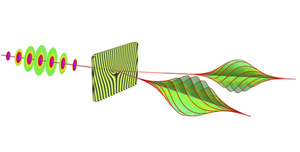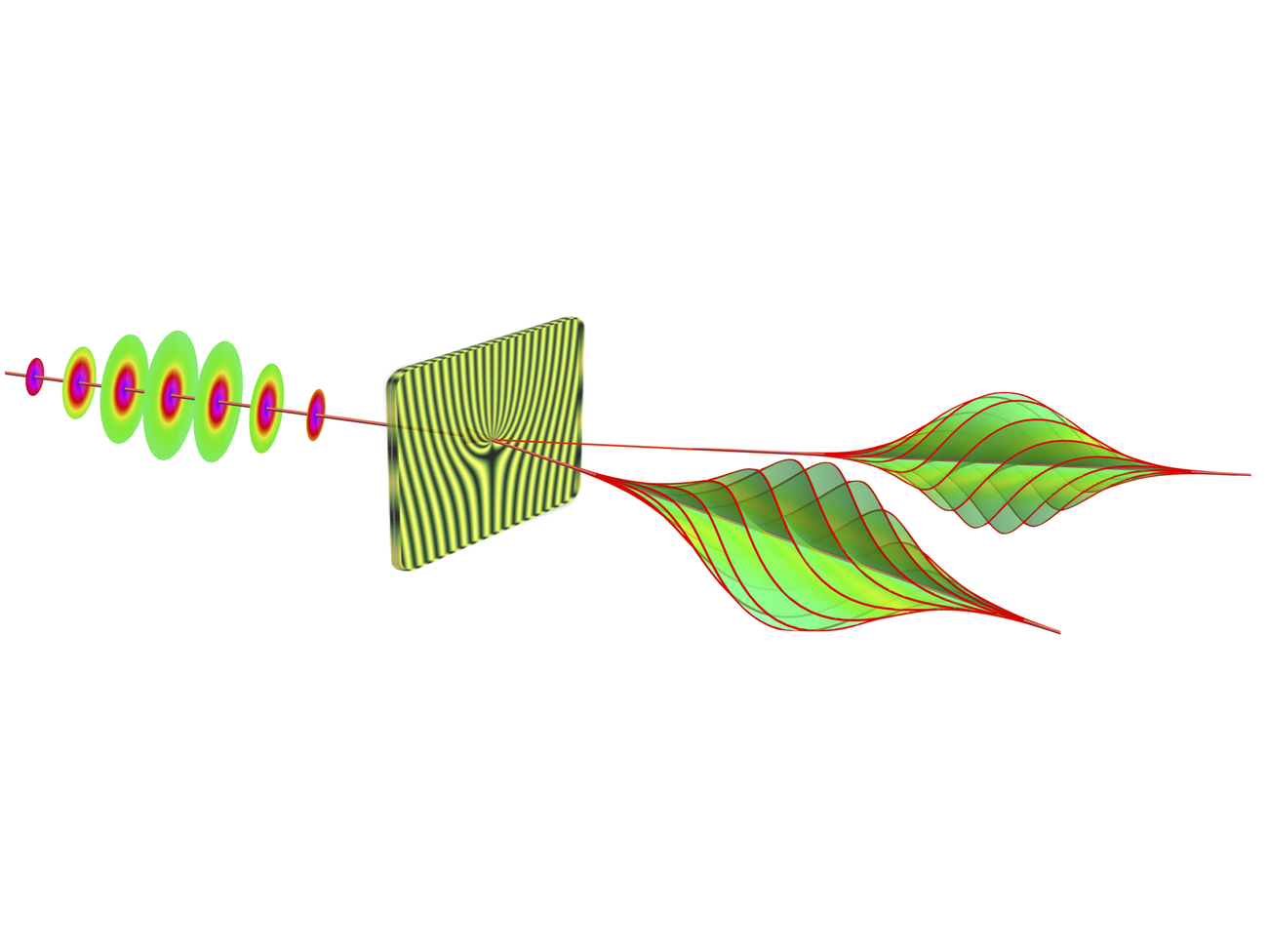Big Twist for Electron Beam
If a light beam has a corkscrew-shaped wavefront, rather than the usual series of flat planes, it carries orbital angular momentum, the property we usually associate with a planet or an orbiting electron. In the past few years, experimenters have shown a similar effect in electron beams, thanks to the wavelike nature of electrons. Now a team has demonstrated intense electron beams with angular momentum hundreds of times greater than the electron’s spin, which could be used both for fundamental studies and to probe the properties of magnetic materials.
A typical light wave has an electric field that oscillates, for example, alternately pointing up, then down, then up. For the simplest wave type, the wavefronts are parallel planes: if you freeze the wave in time and look at a plane slicing perpendicular to the propagation direction, the field at every location in that plane will have the same strength and direction. But in a so-called vortex beam, the wavefront forms a corkscrew-shaped surface, and the beam carries orbital angular momentum (OAM), rotational momentum around the helix’s axis. The tighter the helix, the more OAM. For years, researchers have used light with OAM to generate motion, for example, to exert a rotational force on nanoparticles.
Electrons have wave properties similar to those of light, and five years ago several groups made electron beams with OAM. Since the beam is charged, the OAM results in a circulating electric current, which generates a magnetic field parallel to its propagation direction. Researchers would like to use such beams to study atomic scale magnetism in materials such as those in disk drives, but it has been hard to create intense beams with large OAM values. So Ebrahim Karimi of the University of Ottawa, Canada; Vincenzo Grillo of the Italian National Research Council (CNR); and their colleagues, began working to create intense electron beams with high angular momentum.
The standard technique for generating a vortex electron beam is closely related to the textbook optical diffraction grating, a barrier with a series of closely spaced slits. Light sent through the grating produces output beams only in particular directions (“spots”), where the electric field of light waves arriving from all slits point in the same direction and reinforce one another.
The usual grating produces beams with planar wavefronts. To make helical wavefronts, researchers have used more complicated gratings, in which the slits in some regions are slightly shifted in the plane with respect to other regions. These small shifts affect the relative synchronization of light emerging from each region. Independently, each region would produce spots with plane wavefronts, but the combination produces a beam with OAM.
The first demonstrations of this technique with electrons used lines that blocked the particles between the “slits,” reducing the beam intensity. But about a year ago, the Ottawa-CNR collaboration demonstrated this technique using a transparent “phase grating,” which allowed far more electrons to pass through [1]. This type of grating uses variations in the thickness to achieve “effective” slits.
In this previous work, the researchers used a saw-tooth profile for the grating cross section at each “slit.” This shape preferentially directed the electrons in the direction of a particular diffraction spot. In their latest work, they used a simpler, sine-wave profile, which allowed the more-precise patterning required for high OAM. Measurements of the diffracted beam confirmed that the electrons had angular momenta in a range near 200 units, meaning that a helical wavefront makes 200 revolutions in the space of one wavelength. This is twice the highest previous value even though the new beam was 30 times as intense as the previous OAM record-holder, says Karimi.
An electron microscope employing such beams could map the magnetization at the nanoscale in materials, Karimi says. He says researchers could also potentially detect the sonic-boom-like radiation that is predicted to emerge when such a beam with a high magnetic moment transits a material.
The work represents an “evolution of the approach from 2010,” says Jun Yuan of the University of York, UK, and is a good balance between high angular momentum and “relatively high intensity.” But Yuan notes that the researchers are still exploring some important technical limitations and tradeoffs regarding the quality of the beam the technique can produce.
This research is published in Physical Review Letters.
–Don Monroe
Don Monroe is a freelance science writer in Murray Hill, New Jersey.
References
- V. Grillo, G. C. Gazzadi, E. Karimi, E. Mafakheri, R. W. Boyd, and S. Frabboni, “Highly Efficient Electron Vortex Beams Generated by Nanofabricated Phase Holograms,” Appl. Phys. Lett. 104, 043109 (2014)





